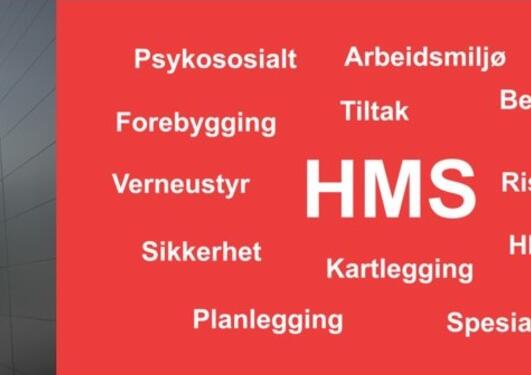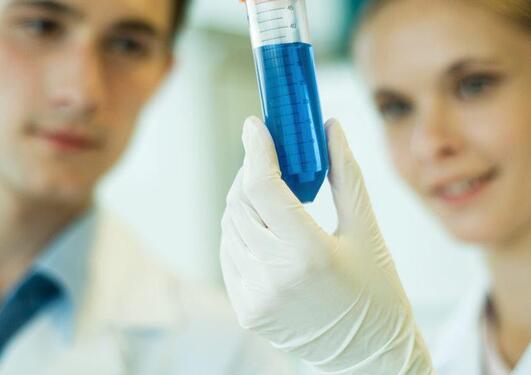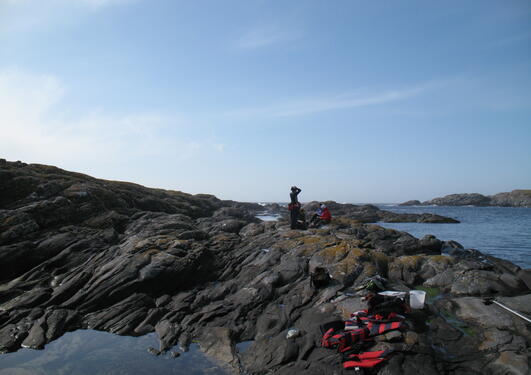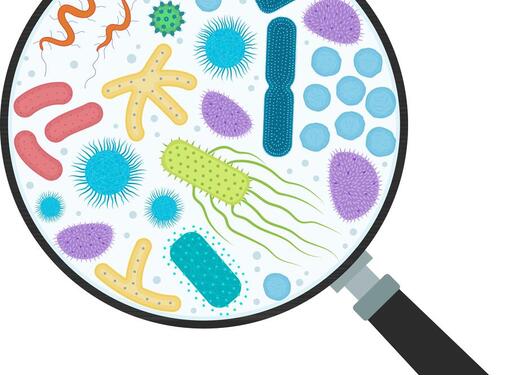Work involving laboratory animals, genetically modified organisms (GMOs) and biological risk factors at BIO

Main content
RESEARCH INVOLVING ANIMALS
BIO has 5 approved laboratory facilities for research on animals, where each facility has a room manager. See contact list for names.
- Livestock section, T53A: Fish, decapod crustaceans and squid
- Zebra fish lab, T 55: Fish
- Salmon lice lab, T 55: Fish, crayfish and squid
- Laboratory animal department, T 55: Fish, centipedes and squid
- Marine biological field station, Espelandsveien 232: Fish, crayfish and squid
Regulations and application for use of animals in scientific research
The use of anaimals in experiments is regulated by the regulations of the use of animals in experiments. Forskrift om bruk av dyr i forsøk - Lovdata Norwegian only. The Norwegian Food Safety Authority is responsible for the management of laboratory animals, including authorization of applications.
In accordance with regulations, BIO has established an animal welfare committee. All applications must first be processed by the animal welfare committee at BIO, before they are sent to the Norwegian Food Authority. Expected processing time, from submission of application to processing by the Norwegian Food Safety Authority, is up to 3 months.
In order to submit an application, you must first create an account in FOTS (Laboratory Animal Committee’s supervision and application system). Contact the leader of the animal welfare comittee at BIO to create such an account.
For more detailed information about current regulations, application forms and how to report the use of use of animal in research, see the Norwegian Food safety Authority’s webpage. Forsøksdyr | Mattilsynet (only available in Norwegian).
NORECOPA
BIO is a member of Norecopa. Norecopa's overall goal is to promote the use of "the 3 R's" in Norway. (Replacement, Reduction, Refinement): Norecopa
RESPONSIBILITIES AT BIO
The overall responsibilities follow the lines of the organization and are stated in the organizational description for the Department of biological sciences.
- Head of department: must ensure that the requirements in the regulation are met and establish an animal welfare unit
- Animal welfare comittee shall work in accordance with §26 of the regulations the use of animals in experiments. The committee shall prepare operating procedures to monitor, report and follow up the welfare of the animals.
- Project manager/researcher working with laboratory animals must ensure that the animal welfare committee is informed of new applications before the application is submitted to the Norwegian Food Safety Authority for approval.
- Room manager with special responsibilities. The room manager shall control welfare and routines for animal care. This includes responsibility for
- Housing conditions, including animal density, system for monitoring environmental parameters, system for regular control and maintenance of equipment, frequency of care and feeding, guard arrangements and alarm systems
- That people who works with the animals meet the requirements for the necessary competence. This involves responsibility for courses and practical training being carried out and for such implementation to be documented.
- That people who works with the animals have access to relevant information about the animal species.
- Employees and students who work with laboratory animals must comply with the applicable procedures and waste management that apply at the respective facilities.
REQUIREMENTS FOR WORKING WITH LABORATORY ANIMALS
Everyone who is going to carry out experiments with animals must have an approved course in laboratory anaimal studies (FELASA). For working with animals, you need to take the core module LAS 301 and in addition LAS 303 for fish research.
BIOLOGICAL RISK FACTORS AND GENETICALLY MODIFIED ORGANISMS (GMO)
Employees and students are obliged to familiarise themselves with UiB's guidelines for work with biological risk factors and for work with genome-modified microorganisms. You are obliged to familiarise yourself with the guidelines available on UIB's HSE-gateway, in addition to the internal rules at BIO.
Definitions
Biological risk factors can be anything from living or dead biological material such as bacteria, fungi, parasites, cell cultures, viruses, prions, toxins and allergens. These are factors that can pose a risk of infection for employees and students working with such factors.
Genetically modified organisms (GMOs) are defined as microorganisms, plants and animals in which the genetic composition has been altered through use of genetic or cell technology. Includes all types of organisms and is the most used abbreviation.
All work with biological risk factors and GMOs must be reported to the Norwegian Directorate of Health and be within the scope of BIO's authorisation. In addition, all work with biological risk factors and GMOs must be risk assessed and necessary measures must be implemented to ensure safety and that work takes place within the correct containment level.
Responsibilities
Head of Administration: must ensure that rules are followed when starting up new projects at BIO.
HSE coordinator: shall be a driving force for risk assessment and assist when needed.
Project managers: Are responsible for ensuring that the research conducted in BIO's laboratories is within the authorisations that BIO has from the authorities regarding GMOs and biological factors. The project manager must also ensure that all work is risk assessed in collaboration with the lab manager. The risk assessment must be in writing. In addition, the project manager must ensure that there are written work instructions/protocols for the various tasks.
Lab manager: Is responsible for ensuring that new employees and students receive a guided tour and training in HSE safety pass, including work with GMOs. Assist the project manager in the risk assessment and write work instructions/protocols for the different tasks.
Room manager: people with room responsibility must ensure that rules and procedures are followed. Provide training in the use of instruments and report any deviations.
Students: must be aware that they are working with GMOs or biological factors, and work in accordance with good laboratory practice. Must sign the HSE- safety pass and must have knowledge of risk assessment and safe job analysis.
All: The individual researcher/technician/employee/student is responsible for keeping records when working with GMOs. The journal must be able to be presented in the event of an inspection by the authorities.
Work instructions
The research group leader/lab manager is responsible for ensuring that written work instructions are available for the various tasks. The routines must ensure that the work is carried out without risk to the health and safety of the employee and without harming the environment. The work instructions must also describe the measures to be taken in the event of an accident. Each employee and student are responsible for ensuring that the work instructions are followed. The procedures must be available for inspection by the authorities.
GMOs AND BIOLOGICAL RISK FACTORS - MANDATORY REPORTS AND APPLICATIONS
At BIO, we currently have GMO activities involving the use of zebrafish and fruit flies, which require individual authorisation for each project, and generic use of GMMs (including bacteria, yeast and cell lines) which is registered as a group with the public authorities, Helsedirektoratet, in 2013.
Research group leaders, project managers and subject teachers must confirm whether the GMO-activity still is within the known research – and teaching activities as describes in the department’s “Overview of GMO” when:
- Applying for new project funds
- Onboarding new employees or guest researchers in the research groups
- Modifying laboratory tasks in our subjects
The GMO overview at BIO is available upon request to administration manager or HSE coordinator.
Planning of new activities
When planning for new activity involving biological factors, work including usage of new genetically modified microorganisms (GMM) or vectors not included in the department’s “Overview of GMO”, a risk assessment must be undertaken in order to determine requirements related to containment level and in order to ensure the department’s facilities and routines are approved for the planned work. The department must report the new usage of GMO to the public authorities, refer regulations on contained usage of GMO.
Obligation to report
- Planning for new activity with the use of biological factors in infection risk group 2,3 and 4 requires a notification to the Norwegian Labour Inspection Authority at least 30 days before use.
- All GMO-activity involving zebra fish and fruit flies requires an individual application and approval for each project. The project manager is responsible both for making the application and getting approval from the public authorities (Helsedirektoratet) for the contained usage, as well as informing the department and leader of the zebra fish facilities and the fruit fly lab of both application and approval.
WORKING WITH GMOs AND BIOLOGICAL RISK FACTORS AT BIO
BIO only has facilities for working with biological risk factors and GMOs at containment levels 1 and 2. Contact the HSE coordinator/administrative manager if you need more information. Employees and students who will be working in BIO's laboratories must have completed an HSE safety pass and received training in the safe handling of biological factors and working with GMOs.
- The project manager is responsible for ensuring that the project is approved by the department as well as the authorities.
- There must be a written risk assessment for work with GMO/GMM and biological risk factors. Use the risk assessment form for GMOs and biological factors available on the HSE-gateway and the reporting form to assess and classify the risk of working with GMOs.
- Work with GMOs requires written reports to be kept of the work carried out. This must be able to be presented in the event of an inspection.
- Work with biological risk factors in infection risk groups 3 and 4 must be registered in the exposure register. BIO does not have facilities to work with risk factors in this infection group.
- UiB has established a committee for biosafety, which is an advisory board that can assist in questions relating to biological factors and GMOs. See the HSE-gateway for more detailed information. Biological factors and genetically modified microorganisms | The HSE-gateway | UiB
Registration
For biological risk factors that pose a risk to workers' health and the environment, we are obliged to prepare an information sheet that must be registered in the chemical inventory system. A copy of the information sheet must be sent to the department's HSE coordinator. This form can also be used to assess and classify risks associated with GMOs. Biological factors and genetically modified microorganisms | The HSE-gateway | UiB
Waste management
UiB practice zero discharge into the drain. Most antibiotics and plasmids with antibiotic resistance are not sufficiently destroyed by autoclaving. Autoclaved biological waste should therefore not be poured down the sink.
- Biological waste (GMO) above 1 L must first be autoclaved before pouring into a leak-proof container (e.g. empty ethanol bottles), and then handled as problematic waste. Alternatively, Virkon can be added to the liquid waste at 1% before autoclaving before handling as problematic waste.
- Small quantities of biological liquid waste such as falcon tubes, eppendorf tubes should be handled as problematic waste (yellow waste container)
- Solid waste such as agar plates must be handled as problematic waste and should be placed into yellow waste container.
- For GMO zebrafish, follow the internal waste guidelines that apply in the zebrafish facility.
- Fruit flies, follow the internal waste guidelines that apply in the fly lab.
Measures in the event of accidents, injuries and spills
Any accidents or undesirable incidents must be reported as a HSE non-conformity. Report HSE non-conformities | The HSE-gateway | UiB
- Stab and cut injuries: For more information regarding the handling of stab and cut injuries, we refer to Stab, cut and bite injuries | The HSE-gateway | UiB
- Measures in the event of spillage
- Spills of material containing genetically modified organisms must be immediately wiped up with absorbent paper which must be thrown into yellow plastic boxes for incineration. The area must be disinfected using 70% ethanol or treated with Virkon/chloramine. Use protective equipment such as gloves and lab coat
- If you are unable to disinfect immediately, you must
- mark the area that may be contaminated
- possibly block off the area to avoid infection/contamination of people.
- possibly call for help
- start disinfection (70% ethanol or disinfectant liquid)
- record the biological factor
- report to superior (research group leader and head of administration)
- report this as an HSE non-conformity
The Norwegian Directorate of Health must be notified of all accidents that lead to the release of GMOs.
Notification in the event of a spill or other accident
According to the Genetic Engineering Act, the Directorate of Health must be notified immediately if an accident or other unforeseen circumstances occur during the production and use of genetically modified organisms.
The notification to the Directorate of Health is sent via the department’s head of administration.
In the event of a release or possible release, the notification must describe
- What happened
- why it happened
- possible consequences of the discharge
- which measures have been taken to prevent recurrence
The research group leader is responsible for defining any supplementary rules for handling spills and accidents and include them in the group's work instructions.
Notification in emergency situations
Any employee or student who recognises a possible crisis situation must notify immediately:
Emergency services:
Fire: 110
Police: 112
Ambulance: 113
Vakttelefon UiB: 55 58 85 00 - 24 hours a day (security company passes on the message to
the university's emergency management).





